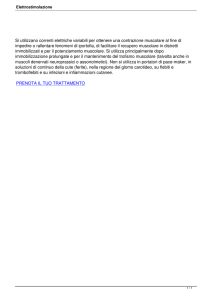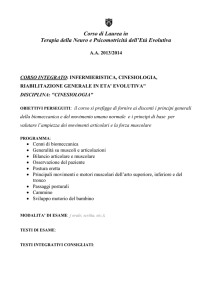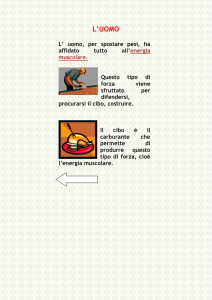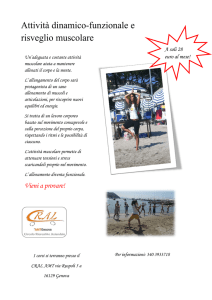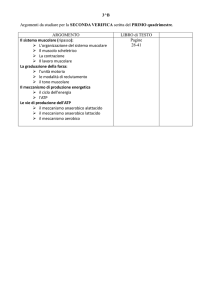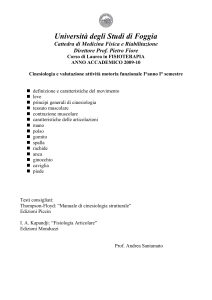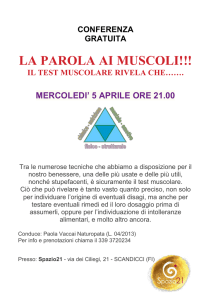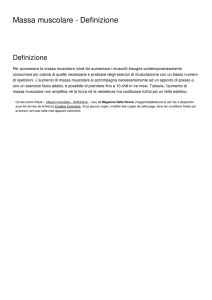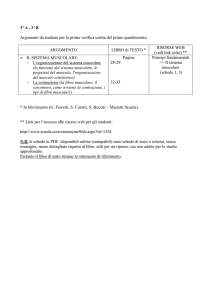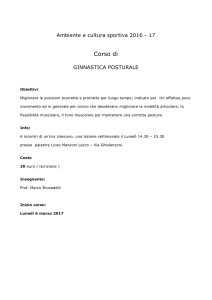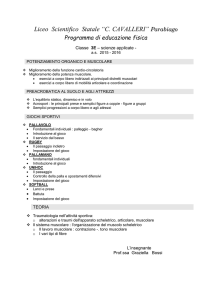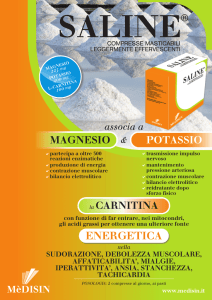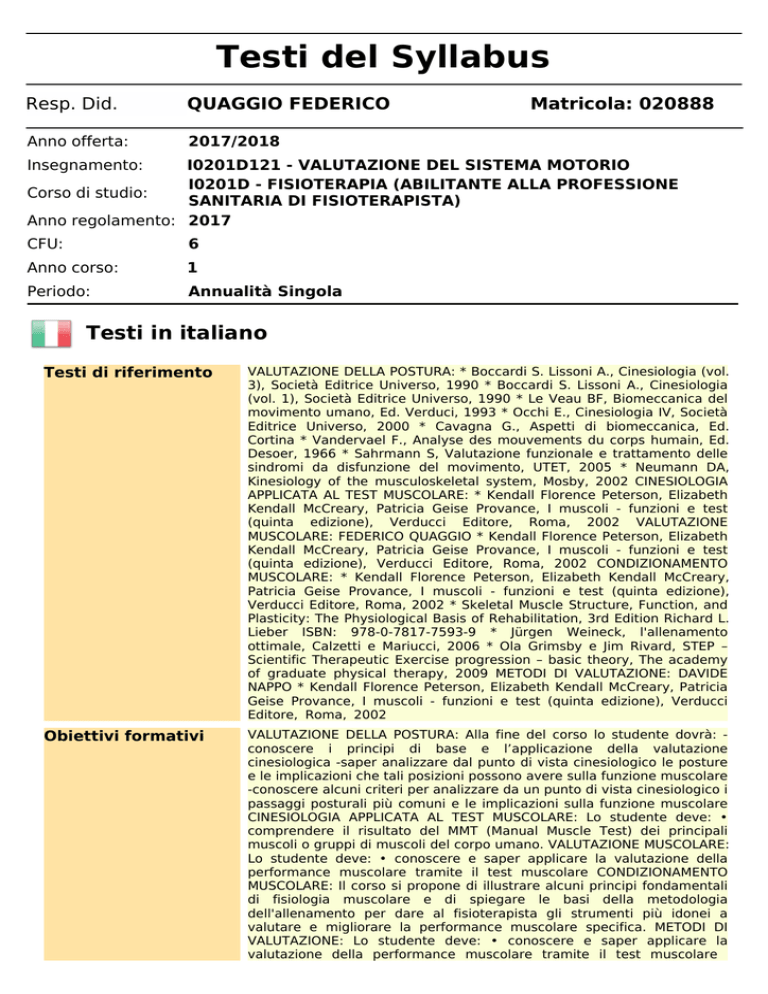
Testi del Syllabus
Resp. Did.
QUAGGIO FEDERICO
Anno offerta:
2017/2018
Matricola: 020888
Insegnamento:
I0201D121 - VALUTAZIONE DEL SISTEMA MOTORIO
I0201D - FISIOTERAPIA (ABILITANTE ALLA PROFESSIONE
Corso di studio:
SANITARIA DI FISIOTERAPISTA)
Anno regolamento: 2017
CFU:
6
Anno corso:
1
Periodo:
Annualità Singola
Testi in italiano
Testi di riferimento
VALUTAZIONE DELLA POSTURA: * Boccardi S. Lissoni A., Cinesiologia (vol.
3), Società Editrice Universo, 1990 * Boccardi S. Lissoni A., Cinesiologia
(vol. 1), Società Editrice Universo, 1990 * Le Veau BF, Biomeccanica del
movimento umano, Ed. Verduci, 1993 * Occhi E., Cinesiologia IV, Società
Editrice Universo, 2000 * Cavagna G., Aspetti di biomeccanica, Ed.
Cortina * Vandervael F., Analyse des mouvements du corps humain, Ed.
Desoer, 1966 * Sahrmann S, Valutazione funzionale e trattamento delle
sindromi da disfunzione del movimento, UTET, 2005 * Neumann DA,
Kinesiology of the musculoskeletal system, Mosby, 2002 CINESIOLOGIA
APPLICATA AL TEST MUSCOLARE: * Kendall Florence Peterson, Elizabeth
Kendall McCreary, Patricia Geise Provance, I muscoli - funzioni e test
(quinta edizione), Verducci Editore, Roma, 2002 VALUTAZIONE
MUSCOLARE: FEDERICO QUAGGIO * Kendall Florence Peterson, Elizabeth
Kendall McCreary, Patricia Geise Provance, I muscoli - funzioni e test
(quinta edizione), Verducci Editore, Roma, 2002 CONDIZIONAMENTO
MUSCOLARE: * Kendall Florence Peterson, Elizabeth Kendall McCreary,
Patricia Geise Provance, I muscoli - funzioni e test (quinta edizione),
Verducci Editore, Roma, 2002 * Skeletal Muscle Structure, Function, and
Plasticity: The Physiological Basis of Rehabilitation, 3rd Edition Richard L.
Lieber ISBN: 978-0-7817-7593-9 * Jürgen Weineck, l'allenamento
ottimale, Calzetti e Mariucci, 2006 * Ola Grimsby e Jim Rivard, STEP –
Scientific Therapeutic Exercise progression – basic theory, The academy
of graduate physical therapy, 2009 METODI DI VALUTAZIONE: DAVIDE
NAPPO * Kendall Florence Peterson, Elizabeth Kendall McCreary, Patricia
Geise Provance, I muscoli - funzioni e test (quinta edizione), Verducci
Editore, Roma, 2002
Obiettivi formativi
VALUTAZIONE DELLA POSTURA: Alla fine del corso lo studente dovrà: conoscere i principi di base e l’applicazione della valutazione
cinesiologica -saper analizzare dal punto di vista cinesiologico le posture
e le implicazioni che tali posizioni possono avere sulla funzione muscolare
-conoscere alcuni criteri per analizzare da un punto di vista cinesiologico i
passaggi posturali più comuni e le implicazioni sulla funzione muscolare
CINESIOLOGIA APPLICATA AL TEST MUSCOLARE: Lo studente deve: •
comprendere il risultato del MMT (Manual Muscle Test) dei principali
muscoli o gruppi di muscoli del corpo umano. VALUTAZIONE MUSCOLARE:
Lo studente deve: • conoscere e saper applicare la valutazione della
performance muscolare tramite il test muscolare CONDIZIONAMENTO
MUSCOLARE: Il corso si propone di illustrare alcuni principi fondamentali
di fisiologia muscolare e di spiegare le basi della metodologia
dell'allenamento per dare al fisioterapista gli strumenti più idonei a
valutare e migliorare la performance muscolare specifica. METODI DI
VALUTAZIONE: Lo studente deve: • conoscere e saper applicare la
valutazione della performance muscolare tramite il test muscolare
Metodi didattici
Lezioni frontali e esercitazioni
Modalità di verifica
dell'apprendimento
Quiz a risposta singola con 5 risposte di cui una sola esatta Domande a
Risposta Aperta, Prova orale/pratica
Programma esteso
VALUTAZIONE DELLA POSTURA: * Differenza tra postura e stazione *
Schema generale per l'analisi cinesiologica di ogni stazione. * La stazione
eretta “normale” e variazioni possibili rispetto alla postura ideale (Sway
back, cifo-lordotica.) * Le stazioni derivate dalla stazione eretta - La
stazione piegato in avanti - La stazione piegato indietro - La stazione
piegato di lato - La stazione a ginocchia flesse - La stazione in punta di
piedi - La stazione in appoggio monopodalico * La stazione in decubito *
La stazione seduta * La stazione in ginocchio * La stazione intermedia o a
cavalier servente * I passaggi posturali - Passaggio dalla stazione seduta
alla stazione eretta e viceversa - Passaggio dalla stazione in ginocchio
alla stazione intermedia - Passaggio dalla stazione intermedia alla
stazione eretta * I gesti: - Salire e scendere le scale - Sollevare ed
abbassare CINESIOLOGIA APPLICATA AL TEST MUSCOLARE: • I rapporti
tra allineamento e attività muscolare • Il movimento normale • Schemi di
reclutamento di alcuni movimenti elementari VALUTAZIONE MUSCOLARE:
• Il break test per valutare la forza di un muscolo secondo un grading
definito • Le disfunzioni muscolari di base: debolezza, rigidità, muscolo
corto, muscolo lungo • TMM dei muscoli del tronco, capo e collo:
estensori, flessori, rotatori ed addominali • TMM dei muscoli dell'arto
superiore: spalla, gomito, polso, mano CONDIZIONAMENTO MUSCOLARE:
In base ai principi del condizionamento muscolare si tratteranno: *
caratteristiche del tessuto contrattile * caratteristiche del tendine *
caratteristiche del tessuto di sostegno del muscolo * metabolismo
muscolare * le modificazioni del tessuto muscolare in reazione ai diversi
stimoli:
immobilizzazione
in
allungamento
o
accorciamento,
elettrostimolazione, attivazione volontaria, allenamento del gesto
specifico La parte riguardante la metodologia dell'esercizio muscolare
riguarderà in particolare: * tipi di contrazione e loro peculiarità:
isometrica, eccentrica, concentrica, pliometrica * Teoria dell'allenamento:
obiettivo e stimolo ottimale per raggiungerlo * le basi metodologiche
dell'allenamento alla forza * le basi metodologiche dell'allenamento alla
resistenza * le basi metodologiche dell'allenamento alla potenza *
stretching e modificazioni della lunghezza muscolare * strategie per il
recupero METODI DI VALUTAZIONE: • TMM dei muscoli dell'anca, della
coscia, del ginocchio, del piede e della caviglia.
Testi in inglese
Testi di riferimento
POSTURE ASSESSMENT KINESIOLOGY APPLIED TO THE MANUAL MUSCLE
TEST MUSCULAR ASSESSMENT MUSCULAR CONDITIONING ASSESSMENT
METHODS
Obiettivi formativi
POSTURE ASSESSMENT At the end of the course the student should : know the basic principles and application of the kinesiologic assessment.
- know the assessment of postures and implication of postures on the
musculature. - know and analyze passages between postures
KINESIOLOGY APPLIED TO THE MANUAL MUSCLE TEST The student should
: - understand the results of the MMT of the main muscles or muscle
groups of the human body MUSCULAR ASSESSMENT The student should :
- know and know to apply the assessment of the muscular performance
trough the manual muscle test (MMT) MUSCULAR CONDITIONING The
student should : - know and know to apply the assessment of the
muscular performance trough the manual muscle test (MMT) understand the results of the MMT of the main muscles or muscle groups
of the human body The course aims to show the main principles of
muscular physiology and to illustrate the basis of the training
methodology in order to give to the physical therapist the appropriate
tools for the assessment and training of the specific muscular
performance. ASSESSMENT METHODS The student should : - know and
know to apply the assessment of the muscular performance trough the
manual muscle test (MMT)
Programma esteso
POSTURE ASSESSMENT - differences between posture and position and
general scheme for the kinesiologic assessment in every position. standing posture - derived posture from standing and how to reach them:
movement of the spine, side lying, sitting posture, posture on knees,
intermediate posture, hand and knees posture. - passages between
postures: - climbing stairs - raising and lowering objects KINESIOLOGY
APPLIED TO THE MANUAL MUSCLE TEST - Relationships between
alignment and muscular activity - The physiologic movement Recruitment schemes of a selection of elementary movements
MUSCULAR ASSESSMENT - The break test for the muscular evaluation
based on a defined grading - Basic muscular dysfunction: weakness,
stiffness, shortness and long muscles. - MMT of the trunk, head and neck:
extensors, flexors, rotators and abdominals - MMT of the upper limb
muscles MUSCULAR CONDITIONING Based on the principles of muscular
conditionig the course will cover: - characteristics of the contractile tissue
- tendon characteristics - characteristics of the support structures of the
muscle - muscular metabolism - the modifications of the muscular tissue
in relationship with the stimulus: immobilization in elongated position or
in shortened position, electrostimulation, voluntary contraction, training
of the specific task the methodology of the training will cover: - type of
muscular contraction and their characteristics - theory if the training:
objectives and optimal stimulus to achieve it - methodological basis for
the resistance training - methodological basis for the power training stretching and muscular modifications in length - recover strategies relationships between alignment and muscular activity - the physiologic
movement - recruitment schemes of a selection of elementary
movements - the break test for the muscular evaluation based on a
defined grading - basic muscular dysfunction: weakness, stiffness,
shortness and long muscles. ASSESSMENT METHODS - MMT of the hip,
knee, thigh, foot and ankle

